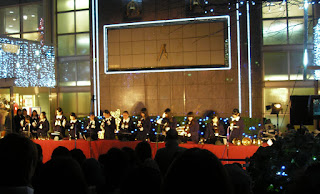
Because of the delay, by the time we found our hotel and checked in almost everything was closing for the day - remember things close at 5pm or earlier here. We walked around the Hiroshima castle grounds. There were a couple of trees that survived the atomic bomb and marked with plaques but most stuff had to be reconstructed, repaired, and regrown. This is true for the city, not just Hiroshima castle.


Then we walked over the the A-bomb Dome. This is the epicenter of the attack, the atomic bomb exploded 600 meters above this building. The city keeps the remains as a monument to peace and the hope of one day there being full nuclear disarmament.
That evening we had Hiroshima style okonomiyaki. Every Japanese person who knew we were going insisted we had to try Hiroshima style. We're used to Osaka style where people mix cabbage into a pancake-like batter, fry that up, put some kind of topping on, and then slather it in sauce. In Hiroshima things are in layers. There is a bottom pancake, cabbage, noodles, top pancake, topping and then the sauce. I think both are equally delicious.

The next day we took a ferry to Itsukushima island, specifically Miyajima. This island is famous for being one of the three great views of Japan, a list that was established in the 1600's. The Itsukushima shrine has a giant torii gate which is out in the water during high tide and easily approachable during low tide.




We decided to climb to the highest point on the island via stone stairs. It was literally an hour and 40min of walking up stairs. There was a shrine on the top and a 360 degree view of the island.




 The shrine at the top had lots of what we refer to as Japanese putti.
The shrine at the top had lots of what we refer to as Japanese putti.


We opted to take the cable car down the mountain and were able to walk up to and touch the torri gate at low tide.

We went to Shukukeien gardens and the Peace Memorial Park and Museum on our last day. The gardens were originally established in 1620 and had your Japanese garden staples – stone lanterns, koi (carp) pond, trickling streams, elegantly placed stones, tea house etc. You could buy food to feed to the carp and they would pile on top of each other to get to it. We've decided that we are no longer going to refer to over eating as “ate like a pig” but rather “ate like a koi.”







After the garden we walked through the Peace park and took about 3 hours going through the museum - everything was written in Japanese and English. The museum began with a history of Hiroshima up to the bombing, then it went into the historical development of the bomb – they even mentioned Lise Meitner but gave Otto Hahn too much credit. They then showed and described the aftermath. This was the gory section. There was a photo of a woman who was wearing a kimono with a black pattern at the time of the blast. All of the black sections were burned into her skin from the heat of the explosion.
Every time a country does any nuclear testing the current mayor of Hiroshima sends them a letter expressing concern and a desire to end all nuclear weapons programs. Copies are hung in the museum and there are way too many of them.








